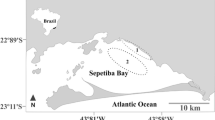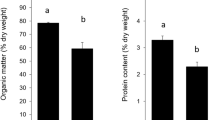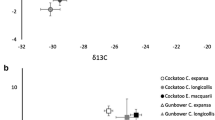Summary
The relationship between food preference and food quality (i.e. a food's contribution to growth and reproductive development) was examined in the laboratory for 3 species of herbivorous kelp forest gastropods (Tegula). The preference hierarchies of the 3 Tegula for 6 common algal species are the same: giant kelp (Macrocystis) is the most preferred food and brown algae are consumed at higher rates than red algae. Despite their strong preference for Macrocystis, the 3 species had significantly greater growth and/or reproductive development on a mixed-algae diet than on either brown or red algae alone. Laboratory preferences of the snails did not correspond closely with caloric content, estimated availability or quality of the algal species used in this study. However, the 3 Tegula are subject to strong benthic predation and Macrocystis provides an important spatial refuge in nature. The potential role of non-nutritional factors such as predator avoidance on the formation of food preferences is discussed.
Similar content being viewed by others
References
Carefoot TH (1967) Growth and nutrition of Aplysia punctata feeding on a variety of marine algae. J Mar Biol Assoc UK 47:565–589
Carefoot TH (1970) A comparison of absorbtion and utilization of food energy in two species of tropical Aplysia. J Exp Mar Biol Ecol 5:47–62
Carefoot TH (1973) Feeding, food preference and uptake of food energy by the supralittoral isopod Ligia pallisii. Mar Biol 18:228–236
Covich AP (1976) Analyzing shapes of foraging areas: some ecological and economic theories. Annu Rev Ecol Syst 7:235–257
Curtis LA, Hurd LE (1979) On the broad nutritional requirements of the mud snail Ilyanassa (Nassarius) obsoleta (Say)and its polytrophic role in the food web. J Exp Mar Biol Ecol 41:289–297
Emlen JM (1966) The role of time and energy in food preference. Am Nat 100:611–617
Greenstone MH (1979) Spider feeding behavior optimises dietary essential amino acid composition. Nature 282:501–503
Himmelman JH, Carefoot TH (1975) Seasonal changes in calorific values of three pacific coast seaweeds, and their significance to some marine invertebrate herbivores. J Exp Mar Biol Ecol 18:139–151
Kitting CL (1980) Herbivore-plant interactions of individual limpets maintaining a mixed diet of intertidal marine algae. Ecol Monogr 50:527–550
Krebs JR (1978) Optimal foraging: decision rules for predators. In: Krebs JR, Davies NB (eds) Behavioral ecology: an evolutionary approach. Sinauer Assoc, Sunderland MA, pp 23–63
Larson BR, Vadas RL, Keser M (1980) Feeding and nutritional ecology of the sea urchin Strongylocentrotus droebachiensis in Maine USA. Mar Biol 59:49–62
Leighton DL (1966) Studies of food preferences in algiverous invertebrates of Southern California kelp beds. Pac Sci 20:104–113
Leighton DL, Boolootian RA (1963) Diet and growth in the black abalone, Haliotis cracherodii. Ecology 44:227–238
Levinton JS (1971) Control of Tellinacean (Mollusca: Bivalvia) feeding behavior by predation. Limnol Oceanogr 16:660–662
McLean JH (1962) Sublittoral ecology of kelp beds of the open coast area near Carmel, California. Biol Bull 122:95–114
Milinski M, Heller R (1978) Influence of a predator on the optimal foraging of sticklebacks (Gasterosteus aculeatus L.). Nature 275:642–644
Nicotri ME (1980) Factors involved in herbivore food preference. J Exp Mar Biol Ecol 42:13–26
North WJ (1971) Biology of the giant kelp beds (Macrocystis) in California. Nova Hedwig. (suppl) 32:1–600
Paine RT (1971) The measurement and application of the calorie to ecological problems. Annu Rev Ecol Syst 2:145–164
Paine RT, Vadas RL (1969) Calorific value of benthic marine algae and their postulated relation to invertebrate food preference. Mar Biol 4:79–86
Pyke GH, Pulliam HR, Charnov EL (1977) Optimal foraging: a selective review of theory and tests. Q Rev Biol 52:137–154
Riedman ML, Hines AH, Pearse JS (1981) Spatial segregation of four species of turban snails (Gastropoda: Tegula) in central California. Veliger 24:97–102
Schoener TW (1971) Theory of feeding strategies. Annu Rev Ecol Syst 2:369–404
Sih A (1982) Foraging strategies and avoidance of predation by an aquatic insect, Notonecta hoffmanii. Ecology 63:786–796
Sokal RR, Rohlf FJ (1969) Biometry. Freeman, San Francisco, p 776
Stamps J, Tanaka S, Krishnan VV (1981) The relationship between selectivity and food abundance in a juvenile lizard. Ecology 62:1079–1092
Vadas RL (1977) Preferential feeding: an optimization strategy in sea urchins. Ecol Monogr 47:337–371
Vance RR, Schmitt RJ (1979) The effect of predator avoidance behavior of the sea urchin Centrostephanus coronatus on the breadth of its diet. Oecologia 44:21–25
Watanabe JM (1982) Aspects of community organization in a temperate kelp forest habitat: factors influencing the bathymetric segregation of three species of herbivorous gastropods. PhD diss, Univ Calif Berkeley, p 237
Watanabe JM (1984) The influence of recruitment, competition and benthic predation on spatial distributions of three species of kelp forest gastropods (Trochidae: Tegula). Ecology, in press
Author information
Authors and Affiliations
Rights and permissions
About this article
Cite this article
Watanabe, J.M. Food preference, food quality and diets of three herbivorous gastropods (Trochidae: Tegula) in a temperate kelp forest habitat. Oecologia 62, 47–52 (1984). https://doi.org/10.1007/BF00377371
Received:
Issue Date:
DOI: https://doi.org/10.1007/BF00377371




